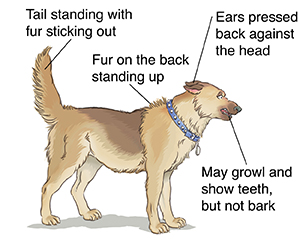For Parents: Animal Safety
For Parents: Animal Safety
At times, friendly dogs and cats can bite and scratch. A pet bird, reptile, or hamster can also bite or scratch. Young children are at special risk. But you can help prevent problems around pets and other animals. Talk with your child about respecting animals.
Signs of a potentially dangerous animal
| |
|
| A cat will make itself look big by arching its back and raising the fur. A cat may also hiss and push its ears back. |
What your child should know
Help your child become aware of animals. Tell your child:
-
Don't run away from a hostile or unknown animal. Move away slowly, giving the animal plenty of space. Tell a parent or other adult about stray or threatening animals.
-
Avoid strange animals, animals that seem sick or afraid, or animals with their young.
-
Never hide an animal bite. Bites can make you sick. Tell an adult right away.
-
Leave sleeping and eating pets alone!
-
Never play biting or attacking games with a pet.
-
Never touch or play with a wild snake. Snakes can bite. Some are poisonous. Others can quickly wrap around you to stop your breathing.
It’s exciting to see animals in the wild. But teach your child to leave them alone. Never feed wild animals. That can make them aggressive.
Updated:
January 20, 2020
Reviewed By:
Adler, Liora C., MD,Bass, Pat F., III, MD, MPH

